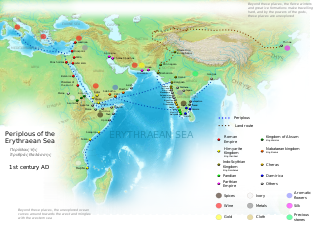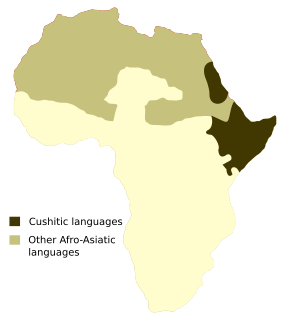Salweyn | |
|---|---|
Archaeological site | |
| Country | |
| Region | Sanaag |
| Time zone | UTC+3 (EAT) |
Salweyn, also known as Salwine, is a proto-Somali archaeological site located in the Sanaag region of Somaliland.
Salweyn | |
|---|---|
Archaeological site | |
| Country | |
| Region | Sanaag |
| Time zone | UTC+3 (EAT) |
Salweyn, also known as Salwine, is a proto-Somali archaeological site located in the Sanaag region of Somaliland.
Salweyn is situated to the east of the old coastal town of Heis. [1] A small eponymous creek is located in the area. [2]
The site contains a very large field of cairns, which stretches for a distance of around 8 km. [1] An excavation of one of these tumuli by Georges Révoil in 1881 uncovered a tomb, beside which were artefacts pointing to an ancient, advanced civilization. The interred objects included pottery sherds from Samos, some well-crafted enamels, and a mask of Ancient Greek design. [2]
Additionally, close to the cairns are a number of rows of standing stones. These menhirs are similar to those at Heis and Botiala. [3]
Along with Macajilayn, Salweyn is also the only local site where specialized ancient disc-like monuments have been found. [1]

Sir Marc Aurel Stein, (Hungarian: Stein Márk Aurél; 26 November 1862 – 26 October 1943) was a Hungarian-born British archaeologist, primarily known for his explorations and archaeological discoveries in Central Asia. He was also a professor at Indian universities.

Egyptology is the study of ancient Egyptian history, language, literature, religion, architecture and art from the 5th millennium BC until the end of its native religious practices in the 4th century AD. A practitioner of the discipline is an "Egyptologist". In Europe, particularly on the Continent, Egyptology is primarily regarded as being a philological discipline, while in North America it is often regarded as a branch of archaeology.

Sanaag is an administrative region (gobol) in northern Somalia, within the autonomous region of Somaliland. Sanaag has a long coastline facing the Gulf of Aden to the north, and is bordered by the Somali regions of Sahil, Togdheer, Sool and Bari. Its capital city is Erigavo.

A tumulus is a mound of earth and stones raised over a grave or graves. Tumuli are also known as barrows, burial mounds or kurgans, and may be found throughout much of the world. A cairn, which is a mound of stones built for various purposes, may also originally have been a tumulus.

A stone circle is a circular alignment of standing stones. They are commonly found across Northern Europe and Great Britain, and typically date from the Late Neolithic and Early Bronze Age eras, with most concentrations appearing from 3000 BCE. The best known examples include those at the henge monument at Avebury, the Rollright Stones, and elements within the ring of standing stones at Stonehenge. Ancient stone circles appear throughout Europe, with many existing in the Pyrenees, on the Causse de Blandas in southern France in the Cevennes, in the Alps, Bulgaria, and Poland. Another type can be found in the Horn of Africa.

Borama is the capital and the largest city of the northwestern Awdal region of Somaliland The commercial seat of the province, it is situated near the border with Ethiopia.

Laas Geel, also spelled Laas Gaal, are cave formations on the rural outskirts of Hargeisa, Somaliland, situated in the Maroodi Jeex region of the country. They contain some of the earliest known cave paintings of domesticated African aurochs in the Horn of Africa. Laas Geel's rock art is estimated to date somewhere around circa 18,000 BC or 20,000 years ago.

Heis is a historic coastal town located in the Sanaag region of Somaliland. The settlement is inhabited by the Habr Je'lo sub-clan of the Isaaq.

Somali studies is the scholarly term for research concerning Somalis and Greater Somalia. It consists of several disciplines such as anthropology, sociology, linguistics, historiography and archaeology. The field draws from old Somali chronicles, records and oral literature, in addition to written accounts and traditions about Somalis from explorers and geographers in the Horn of Africa and the Middle East. The Somali Studies International Association is the primary organization for Somalist scholars. Bildhaan, Somali Studies, Horn of Africa and the Anglo-Somali Society Journal likewise serve as the field's main periodicals. Since 1980, prominent Somalist scholars from around the world have also gathered annually to hold the International Congress of Somali Studies.
Botiala, also known as Bottiala or Bandar Kor, is an archaeological site in the northeastern Bari region of Somalia.

Somali architecture is the engineering and designing of multiple different construction types such as stone cities, castles, citadels, fortresses, mosques, temples, aqueducts, lighthouses, towers and tombs during the ancient, medieval and early modern periods in Somalia and other regions inhabited by Somalis, as well as the fusion of Somalo-Islamic architecture with Western designs in contemporary times.
Damo is an ancient proto-Somali town in northeastern Somalia. It is situated in the autonomous Puntland region, 5 km west of Cape Guardafui.

Mosylon, also known as Mosullon, was an ancient proto-Somali trading center on or near the site that later became the city of Bosaso.

Essina was an ancient Proto-Somali emporium located on the southeastern coast of Somalia in the Horn of Africa.

Fernacre, also known as Fernacre stone circle or Fernacre circle, is a stone circle located on the slopes of the De Lank River, 1.25 miles (2.01 km) northeast of St Breward on Bodmin Moor in Cornwall in the United Kingdom.

The Cushitic peoples are a grouping of people who are primarily indigenous to Northeast Africa and speak or have historically spoken Cushitic languages of the Afroasiatic language family. Cushitic languages are spoken primarily in the Horn of Africa, as well as the Nile Valley, and parts of the African Great Lakes region. Some examples of these peoples include the Cushitic speaking ethnic groups. In some cases, non-Cushitic language speaking ethnic groups with substantial Cushitic ancestry and who have had a language shift towards speaking Ethiosemitic, Central Semitic, Nilo-Saharan and Omotic languages are considered Cushitic peoples.

This is a list of Somali aristocratic and court titles that were historically used by the Somali people's various sultanates, kingdoms and empires. Also included are the honorifics reserved for Islamic notables as well as traditional leaders and officials within the Somali customary law (xeer), in addition to the nobiliary particles set aside for distinguished individuals.
Encyclopedias from ca. 1900 note that ancient tombs, pyramidal structures, ruined towns, and stone walls found in Somalia, such as the Wargaade Wall, are evidence of an old civilization in the Somali peninsula that predates Islam.
Macajilayn, also spelled Mecajilayn, is a proto-Somali archaeological site located in the Sanaag region of Somaliland.